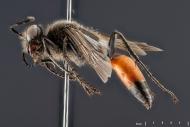Since 2017, the Museum für Naturkunde Berlin has been monitoring insect diversity on the green spaces of the median strips of selected streets in Europe's green capital as part of the "Stadtgrün" project. Frankfurter Allee in Friedrichshain-Kreuzberg, Adlergestell in Treptow-Köpenick and Heerstraße in Charlottenburg-Wilmersdorf were studied. The results are remarkable — at all three sites, the researchers found wonderful interconnected biotopes; and a diversity of species well above expectations. Even species thought to be lost, such as the grasshopper sand wasp, were documented. The project continues to drive a shift in awareness toward greater ecological diversity. District offices, for example, now commit to mowing only once a year to preserve biodiversity.
Berlin is full of habitats: wild boars cavort in the forests on the outskirts of the city, fish swim in Wannsee lake and then, of course, there are the countless pigeons at Alexanderplatz. But it's not only where we suspect animals to be anyway that there is an incessant flurry of creatures. Even in seemingly inhospitable places there are remarkable habitats. The median strips of Berlin's streets, for example, can boast an impressive diversity of insects. This is demonstrated by the Stadtgrün project of the Museum für Naturkunde and Humboldt University, in which entomologist Frank Koch has been examining these unusual urban ecosystems since 2017.
Originally started as a project to study plants resistant to urban stress, Koch and his team put out their feelers for the arthropods at the three locations Frankfurter Allee, Adlergestell and Heerstraße every two weeks. Their results: Koch was able to detect around 400 different insect species from six different orders, including some that are on the red list of endangered species. Even Sphex funerarius, the golden digger wasp, which was thought to have disappeared in Berlin and Brandenburg, came into the researchers' net in 2019. In 2021, the bee species Hylaeus intermedius was documented in Heerstraße for the first time in Germany. More pictures of street life insects shown at Safeguarding Nature.
Koch explains why such amazing biotopes have emerged in the green spaces between the lanes, despite hot asphalt in the summer and road salt in the winter, in part because of their isolated location: "Median strips are avoided by pedestrians and pets," he says, "and so could inadvertently become protected habitats."
Koch sees a danger for the median strip habitats above all in the maintenance of the green strips: Not only would excessive mowing deprive the insects of their food base, warns the entomologist, "it also abruptly changes the preferred abiotic factors, such as temperature, humidity and light." In the fight to protect these unique urban habitats, Koch and his team have won a stage victory: After forceful talks, the green space offices of the districts of Charlottenburg-Wilmersdorf, Friedrichshain-Kreuzberg and Treptow-Köpenick committed to mowing only once a year in the future.
In other respects, too, the Museum für Naturkunde is concerned with the preservation and increase of biodiversity; especially of the insect population. Since summer 2023, visitors have been able to admire a garden from the Pollinator Pathmaker project on the museum's forecourt. The planting of such gardens is optimized for the needs of pollinating insects — and thus contributes to the improvement of local biodiversity.
